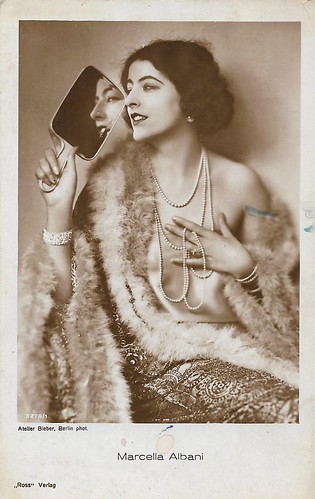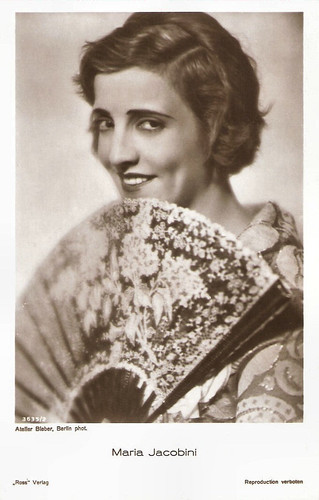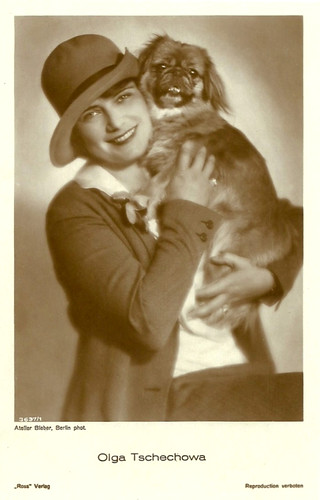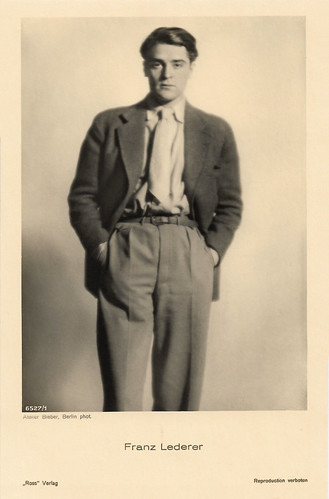Atelier Bieber was one of Germany's oldest photo studios. The studio was founded in 1853 by a Jewish woman, Emilie Bieber, one of the first German photographers. Originally, the studio was located in Hamburg. Emilie was succeeded by her nephew Leonard Berlin, who opened another studio in Berlin, also under the name Atelier Bieber. During the 1910s and the 1920s, many German stars and directors of the stage and the cinema were photographed here.

German postcard by Ross Verlag, no. 1822, 1927-1928. Photo: E. Bieber, Berlin. Collection: Didier Hanson.
Russian born actress Barbara von Annenkoff appeared as an elegant lady in German films of the 1920s and 1930s.

German postcard by Ross Verlag, no. 3278/1, 1928-1929. Photo: Atelier Bieber, Berlin.
Petite Italian actress and author Marcella Albani (1899-1959) appeared in 50 films from 1919 on. She was especially successful as an elegant Latin lady in the German silent cinema.

German postcard by Ross Verlag, no. 3635/2, 1928-1929. Photo: Atelier Bieber, Berlin.
Among the Italian divas, Maria Jacobini (1892-1944) was an island of serenity, as the late film historian Vittorio Martinelli expressed it. She was the personification of goodness, of simple love. Her weapon was her sweet and gracious smile. In some Italian and later also in some German films, however, she could play as well the vivacious lady, the femme fatale, the comedienne, the hysterical victim, and the suffering mother or wife.

German postcard by Ross Verlag, no. 4056/2, 1929-1930. Photo: Atelier Bieber, Berlin.
Ruth Weyher (1901-1983) was a German actress of the silent cinema, famous for films like Schatten//Shadows (1923), Die keusche Susanne/The Girl in the Taxi (1926) and Geheimnisse einer Seele/Secrets of a Soul (1926).

German postcard by Ross Verlag, no. 4383/1, 1929-1930. Photo: Atelier Bieber.
Elegant German actress Claire Rommer (1904-1996) appeared in about 50 German film productions during the 1920s and the early 1930s. Her successful career suddenly ended with the seizure of power by the Nazis.
Little is known about the life of Emilie Bieber. Wikipedia notes that she was born in 1810 in Hamburg. Only when she was over 40 did she appear as the founder of a photographic studio. In early February 1853, Emilie opened with Adelgunde Köttgen a 'Daguerreotype studio' on the top floor of Gr. Bäckerstraße 26 in Hamburg. The collaboration was short-lived, as Koettgen and her family moved to Düsseldorf in the spring of 1854.
Emilie Bieber took over the studio as the sole owner under the name 'Atelier E. Bieber. Emilie specialised in hand-coloured portraits that could not be recognized as photographs when viewed briefly. After gaining some years of experience and improving the technical possibilities, Emilie Bieber presented her portraits at the first "International Photographic Exhibition" in Berlin in 1865, which the Photographic Association Berlin had organised.
Bieber belonged to a small group of women who pursued a trade. She was involved in the Hamburg women's movement. In the 1850s she was on the board of a kindergarten and was friends with Emilie Wüstenfeld, a German women's rights activist and philanthropist who campaigned for girls' education and female vocational training.
In 1868 Emilie Bieber bought a house at Neuer Jungfernstieg 20 in Hamburg and set up a photographic studio there. Her brother-in-law Julius Berlin was temporarily registered as a resident at both addresses. His son Leonard Berlin later succeeded Emilie Bieber.
Around the age of 65, Emilie Bieber retired from daily work. Her nephew Leonard had entered the photographic studio in 1862. In 1869, the studio presented itself for the first time abroad at the 8th exhibition for photography in Paris, which was organised by the Société française de photographie. Several presentations at international exhibitions followed, such as in 1870 in Paris and at the World Exhibition in 1873 in Vienna.

German postcard by Verlag Hermann Leiser, Berlin, no. 8614, 1916. Photo: Hofphot. E. Bieber, Hamburg. Collection: Didier Hanson.

German postcard by Verlag Hermann Leiser, Berlin, no. 8615. Photo: Hofphot. E. Bieber, Hamburg. Collection: Didier Hanson.
German actor-director Max Reinhardt (1873-1943) was one of the great innovators of the theatre. He also directed several films, including Sumurûn (1910) and Das Mirakel (1912). In 1934, he went into exile and made in Hollywood A Midsummer Night's Dream (1935).

German postcard by Louis Blumenthal, Berlin, no. 7381. Photo: E. Bieber, Hofphotograph, Berlin and Hamburg.
Rudolph Schildkraut (1862-1930) was an Austrian film and theatre actor. From 1905 on, he was one of the most important actors in the ensemble of Max Reinhardt. Schildkraut played in some 28 German and Austrian films in the 1910s. In 1920 he moved to the USA.

German postcard by Ross Verlag, no. 23/1, 1925-1935. Photo: Atelier Bieber, Berlin.
Romanian born actor and director Lupu Pick (1886-1931) started as a silent film actor in German film in 1910, but from 1918 he would also become a prolific film director, known for e.g. his Kammerspielfilms Scherben (1921) and Sylvester (1924).

German postcard by Ross Verlag, no. 1089/1, 1927-1928. Photo: Atelier Bieber, Berlin.
Austrian actor Friedrich Zelnik or Frederic Zelnik (1885-1950) was also one of the most important producers-directors of the German silent cinema. Already in the early 1910s, he became a film star in Germany, but during the 1920s he had his greatest successes there as director-producer of operetta style costume films starring his wife, Lya Mara. A critical success was his drama Die Weber/The Weaver (1927). After 1933, he worked in Great-Britain and he also directed two films in the Netherlands.
In 1875, Emilie Bieber was appointed 'Hof-Photographin' (court photographer) by Crown Princess Victoria. In 1877, when Emilie Bieber celebrated the 25th anniversary of her studio, Atelier Bieber counted 30 employees. These employees included Arnold Mocsigay, who was in charge from 1869 to 1897, Max Jaffé and Johann Hamann, who worked as a retoucher in the late 1870s.
Emilie Bieber was 65 in 1875 and retired. In 1884, Emilie Bieber passed away in her hometown Hamburg. She was interred at the Jüdischer Friedhof Ohlsdorf, a Jewish cemetery in the Ohlsdorf district of Hamburg. After Emilie's death in 1884, her nephew Leonard Berlin (1841-1930) took over the studio "at her will".
In 1887 he was awarded the title of professor by Ernst II Duke of Saxony-Coburg and Gotha. This was followed by further awards such as court photographer, Saxony-Ernestine House Order II. Class and appointment to the court council.
In 1890 he opened a second studio under the name Atelier Bieber - but in Berlin. In 1892 he moved to Berlin with the family. In 1865 Leonard had married Marianne Meyer from Copenhagen in Hamburg.
The Berlin Atelier Bieber was highly regarded. 'Tout Berlin' liked to be photographed by Bieber. In 1910 Leonard retired but the open trading company 'E. Bieber, photographic studio in Hamburg and Berlin' continued. Even in retirement, Leonard Bieber initially remained connected to his profession. He was a curator for the photographic royal schools in Berlin and was a member of the Hamburg and Prussian Chamber of Experts for Works of Fine Arts.
The Hamburg studio was taken over by his son Emil Bieber, who had been a partner since 1902. His photos were greatly appreciated. In 1938, he left Hamburg to protect himself and his family from persecution. The branch in Berlin was taken over in 1910 by the merchant Julius Rosenberg, who in 1918 became the k.k. Court photographer. Atelier Bieber continued at Leipziger Strasse 124 in Berlin until 1929.

German postcard by Verlag Herm. Leiser, Berlin-Wilm., no. 4838. Photo: Atelier E. Bieber, Berlin.
Margarete Schön (1895-1985) is best known for her role as Kriemhild, the beautiful but revengeful princess of Burgundy in Fritz Lang’s silent epic Die Nibelungen (1924). The career of this German stage and film actress spanned nearly fifty years.

Austrian postcard by Iris-Verlag, Berlin, no. 5379. Photo: Bieber, Berlin. Collection: Didier Hanson.
Olaf Fjord (1897-1945) was an Austrian film actor, director, and producer. He appeared in numerous Austrian, German, French, and Czech silent films.

Austrian postcard by Iris Verlag, no. 5381. Photo: E. Bieber, Berlin.
Dita Parlo (1908-1971) was a popular European film star in the late 1920s and early 1930s. She inspired both Dita Von Teese and Madonna, who used Parlo's name & character from L'Atalante for her controversial Sex book and Erotica album.

German postcard by Ross Verlag, Berlin, no. 3635/1, 1928-1929. Photo: Atelier Bieber, Berlin.
Among the Italian divas, Maria Jacobini (1892-1944) was an island of serenity. She was the personification of goodness, of simple love. Her weapon was her sweet and gracious smile. In some Italian and later also in some German films, however, she could play as well the vivacious lady, the femme fatale, the comedienne, the hysterical victim, and the suffering mother or wife.

German postcard by Ross Verlag, no. 3637/1, 1928-1929. Photo: Atelier Bieber, Berlin.
Dignified German-Russian actress Olga Tschechova (1897-1980) was one of the most popular stars of the silent film era. She remained a mysterious person throughout her life, and reportedly, she was a Russian agent in Nazi Germany.

German postcard by Ross Verlag, no. 4665/1, 1929-1930. Photo: Atelier Bieber, Berlin.
German actress Hilda Rosch only appeared in eight films between 1928 and 1931.

German postcard by Ross Verlag, no. 5129/1, 1930-1931. Photo: E. Bieber, Hamburg.
If Weimar cinema had one film star, then it was Emil Jannings (1884-1950) for sure. He was a great actor in the silent era and won the first Oscar for Best Actor. Too bad that during the Third Reich, he worked as a board member for the Ufa propaganda machine.

German postcard by Ross Verlag, no. 6527/1, 1931-1932. Photo: Bieber, Berlin.
Dark and gorgeous looking actor Franz Lederer (1899–2000) had a successful film and stage career, first in Europe, then in the United States as Francis Lederer.

German postcard by Das Programm von Heute für Film und Theater G.m.b.H., Berlin. Photo: Bieber, Berlin/Ross Verlag.
German stage and film actress Heli Finkenzeller (1914-1991) had her greatest successes in popular Ufa comedies of the 1930s and 1940s. After the war, she often played mother roles.
Source: Wikipedia (German).

German postcard by Ross Verlag, no. 1822, 1927-1928. Photo: E. Bieber, Berlin. Collection: Didier Hanson.
Russian born actress Barbara von Annenkoff appeared as an elegant lady in German films of the 1920s and 1930s.

German postcard by Ross Verlag, no. 3278/1, 1928-1929. Photo: Atelier Bieber, Berlin.
Petite Italian actress and author Marcella Albani (1899-1959) appeared in 50 films from 1919 on. She was especially successful as an elegant Latin lady in the German silent cinema.

German postcard by Ross Verlag, no. 3635/2, 1928-1929. Photo: Atelier Bieber, Berlin.
Among the Italian divas, Maria Jacobini (1892-1944) was an island of serenity, as the late film historian Vittorio Martinelli expressed it. She was the personification of goodness, of simple love. Her weapon was her sweet and gracious smile. In some Italian and later also in some German films, however, she could play as well the vivacious lady, the femme fatale, the comedienne, the hysterical victim, and the suffering mother or wife.

German postcard by Ross Verlag, no. 4056/2, 1929-1930. Photo: Atelier Bieber, Berlin.
Ruth Weyher (1901-1983) was a German actress of the silent cinema, famous for films like Schatten//Shadows (1923), Die keusche Susanne/The Girl in the Taxi (1926) and Geheimnisse einer Seele/Secrets of a Soul (1926).

German postcard by Ross Verlag, no. 4383/1, 1929-1930. Photo: Atelier Bieber.
Elegant German actress Claire Rommer (1904-1996) appeared in about 50 German film productions during the 1920s and the early 1930s. Her successful career suddenly ended with the seizure of power by the Nazis.
One of a small group of women who pursued a trade
Little is known about the life of Emilie Bieber. Wikipedia notes that she was born in 1810 in Hamburg. Only when she was over 40 did she appear as the founder of a photographic studio. In early February 1853, Emilie opened with Adelgunde Köttgen a 'Daguerreotype studio' on the top floor of Gr. Bäckerstraße 26 in Hamburg. The collaboration was short-lived, as Koettgen and her family moved to Düsseldorf in the spring of 1854.
Emilie Bieber took over the studio as the sole owner under the name 'Atelier E. Bieber. Emilie specialised in hand-coloured portraits that could not be recognized as photographs when viewed briefly. After gaining some years of experience and improving the technical possibilities, Emilie Bieber presented her portraits at the first "International Photographic Exhibition" in Berlin in 1865, which the Photographic Association Berlin had organised.
Bieber belonged to a small group of women who pursued a trade. She was involved in the Hamburg women's movement. In the 1850s she was on the board of a kindergarten and was friends with Emilie Wüstenfeld, a German women's rights activist and philanthropist who campaigned for girls' education and female vocational training.
In 1868 Emilie Bieber bought a house at Neuer Jungfernstieg 20 in Hamburg and set up a photographic studio there. Her brother-in-law Julius Berlin was temporarily registered as a resident at both addresses. His son Leonard Berlin later succeeded Emilie Bieber.
Around the age of 65, Emilie Bieber retired from daily work. Her nephew Leonard had entered the photographic studio in 1862. In 1869, the studio presented itself for the first time abroad at the 8th exhibition for photography in Paris, which was organised by the Société française de photographie. Several presentations at international exhibitions followed, such as in 1870 in Paris and at the World Exhibition in 1873 in Vienna.

German postcard by Verlag Hermann Leiser, Berlin, no. 8614, 1916. Photo: Hofphot. E. Bieber, Hamburg. Collection: Didier Hanson.

German postcard by Verlag Hermann Leiser, Berlin, no. 8615. Photo: Hofphot. E. Bieber, Hamburg. Collection: Didier Hanson.
German actor-director Max Reinhardt (1873-1943) was one of the great innovators of the theatre. He also directed several films, including Sumurûn (1910) and Das Mirakel (1912). In 1934, he went into exile and made in Hollywood A Midsummer Night's Dream (1935).

German postcard by Louis Blumenthal, Berlin, no. 7381. Photo: E. Bieber, Hofphotograph, Berlin and Hamburg.
Rudolph Schildkraut (1862-1930) was an Austrian film and theatre actor. From 1905 on, he was one of the most important actors in the ensemble of Max Reinhardt. Schildkraut played in some 28 German and Austrian films in the 1910s. In 1920 he moved to the USA.

German postcard by Ross Verlag, no. 23/1, 1925-1935. Photo: Atelier Bieber, Berlin.
Romanian born actor and director Lupu Pick (1886-1931) started as a silent film actor in German film in 1910, but from 1918 he would also become a prolific film director, known for e.g. his Kammerspielfilms Scherben (1921) and Sylvester (1924).

German postcard by Ross Verlag, no. 1089/1, 1927-1928. Photo: Atelier Bieber, Berlin.
Austrian actor Friedrich Zelnik or Frederic Zelnik (1885-1950) was also one of the most important producers-directors of the German silent cinema. Already in the early 1910s, he became a film star in Germany, but during the 1920s he had his greatest successes there as director-producer of operetta style costume films starring his wife, Lya Mara. A critical success was his drama Die Weber/The Weaver (1927). After 1933, he worked in Great-Britain and he also directed two films in the Netherlands.
Court photographer
In 1875, Emilie Bieber was appointed 'Hof-Photographin' (court photographer) by Crown Princess Victoria. In 1877, when Emilie Bieber celebrated the 25th anniversary of her studio, Atelier Bieber counted 30 employees. These employees included Arnold Mocsigay, who was in charge from 1869 to 1897, Max Jaffé and Johann Hamann, who worked as a retoucher in the late 1870s.
Emilie Bieber was 65 in 1875 and retired. In 1884, Emilie Bieber passed away in her hometown Hamburg. She was interred at the Jüdischer Friedhof Ohlsdorf, a Jewish cemetery in the Ohlsdorf district of Hamburg. After Emilie's death in 1884, her nephew Leonard Berlin (1841-1930) took over the studio "at her will".
In 1887 he was awarded the title of professor by Ernst II Duke of Saxony-Coburg and Gotha. This was followed by further awards such as court photographer, Saxony-Ernestine House Order II. Class and appointment to the court council.
In 1890 he opened a second studio under the name Atelier Bieber - but in Berlin. In 1892 he moved to Berlin with the family. In 1865 Leonard had married Marianne Meyer from Copenhagen in Hamburg.
The Berlin Atelier Bieber was highly regarded. 'Tout Berlin' liked to be photographed by Bieber. In 1910 Leonard retired but the open trading company 'E. Bieber, photographic studio in Hamburg and Berlin' continued. Even in retirement, Leonard Bieber initially remained connected to his profession. He was a curator for the photographic royal schools in Berlin and was a member of the Hamburg and Prussian Chamber of Experts for Works of Fine Arts.
The Hamburg studio was taken over by his son Emil Bieber, who had been a partner since 1902. His photos were greatly appreciated. In 1938, he left Hamburg to protect himself and his family from persecution. The branch in Berlin was taken over in 1910 by the merchant Julius Rosenberg, who in 1918 became the k.k. Court photographer. Atelier Bieber continued at Leipziger Strasse 124 in Berlin until 1929.

German postcard by Verlag Herm. Leiser, Berlin-Wilm., no. 4838. Photo: Atelier E. Bieber, Berlin.
Margarete Schön (1895-1985) is best known for her role as Kriemhild, the beautiful but revengeful princess of Burgundy in Fritz Lang’s silent epic Die Nibelungen (1924). The career of this German stage and film actress spanned nearly fifty years.

Austrian postcard by Iris-Verlag, Berlin, no. 5379. Photo: Bieber, Berlin. Collection: Didier Hanson.
Olaf Fjord (1897-1945) was an Austrian film actor, director, and producer. He appeared in numerous Austrian, German, French, and Czech silent films.

Austrian postcard by Iris Verlag, no. 5381. Photo: E. Bieber, Berlin.
Dita Parlo (1908-1971) was a popular European film star in the late 1920s and early 1930s. She inspired both Dita Von Teese and Madonna, who used Parlo's name & character from L'Atalante for her controversial Sex book and Erotica album.

German postcard by Ross Verlag, Berlin, no. 3635/1, 1928-1929. Photo: Atelier Bieber, Berlin.
Among the Italian divas, Maria Jacobini (1892-1944) was an island of serenity. She was the personification of goodness, of simple love. Her weapon was her sweet and gracious smile. In some Italian and later also in some German films, however, she could play as well the vivacious lady, the femme fatale, the comedienne, the hysterical victim, and the suffering mother or wife.

German postcard by Ross Verlag, no. 3637/1, 1928-1929. Photo: Atelier Bieber, Berlin.
Dignified German-Russian actress Olga Tschechova (1897-1980) was one of the most popular stars of the silent film era. She remained a mysterious person throughout her life, and reportedly, she was a Russian agent in Nazi Germany.

German postcard by Ross Verlag, no. 4665/1, 1929-1930. Photo: Atelier Bieber, Berlin.
German actress Hilda Rosch only appeared in eight films between 1928 and 1931.

German postcard by Ross Verlag, no. 5129/1, 1930-1931. Photo: E. Bieber, Hamburg.
If Weimar cinema had one film star, then it was Emil Jannings (1884-1950) for sure. He was a great actor in the silent era and won the first Oscar for Best Actor. Too bad that during the Third Reich, he worked as a board member for the Ufa propaganda machine.

German postcard by Ross Verlag, no. 6527/1, 1931-1932. Photo: Bieber, Berlin.
Dark and gorgeous looking actor Franz Lederer (1899–2000) had a successful film and stage career, first in Europe, then in the United States as Francis Lederer.

German postcard by Das Programm von Heute für Film und Theater G.m.b.H., Berlin. Photo: Bieber, Berlin/Ross Verlag.
German stage and film actress Heli Finkenzeller (1914-1991) had her greatest successes in popular Ufa comedies of the 1930s and 1940s. After the war, she often played mother roles.
Source: Wikipedia (German).
No comments:
Post a Comment